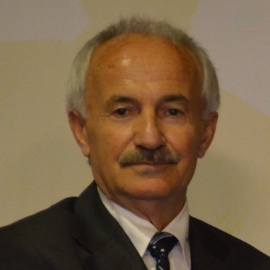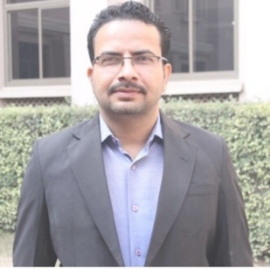Agenda
Conference Schedule
Day 1 full schedule
December 08, 2022 @ 10:00 - 04:45

Osman Adiguzel
ProfessorFirat University
Turkey
ABSTRACT
Shape memory alloys take place in the class of advanced smart materials, with the shape reversibility property and capacity of responding to changes in the environment. These alloys are energy-related materials and exhibit a peculiar property called the shape memory effect, which is characterized by the recoverability of two certain shapes at different temperatures. These phenomena are observed in β- phase region with chemical composition. These transformations are solid-state reactions, martensitic and reverse austenitic transformations do not occur at the same temperature, equilibrium temperature in the energy-temperature diagram, due to the internal frictions and driving force necessary for the transformations.

Ratnesh Das
ProfessorDr. Harisingh Gour Central University, India
India
ABSTRACT
Catalysis is one of the fundamental pillars of green chemistry, the design of chemical products and processes that reduce or eliminate the use and generation of hazardous substances. The design and application of new catalysts and catalytic systems are simultaneously achieving the dual goals of environmental protection and economic benefit.
Implementation of green chemistry principles in the development of industrial wastewater treatment plant

Sara Seršen
Senior ScientistSlovenia
ABSTRACT
The accelerated climate change in rapidly changing the environment and our daily lives. Global warming have been threatening the whole world, for example in the Mediterranean area people are already facing higher water demands with less and less freshwater resources available. On the other hand, industry sectors are producing huge amounts of wastewaters that can become a new source of fresh water and reduce the effluents discharge into municipal sewers, which have become serious threats to the receiving environment.

Ahwan Panigrahi
Indian Institute of Science, BengaluruIndia
ABSTRACT
Imidazole is an important privileged structural motif found in a number of natural products. The natural products containing the imidazole ring act as a pharmacophore with a wide range of biological activities like antibacterial, anti-inflammatory, anticancer, and antiulcer. Because of its significance in medicinal and pharmaceutical chemistry, it is important to synthesize the derivatives of these compounds starting from readily available raw materials. In comparison with transition metal-catalyzed cross dehydrogenative coupling (CDC) reactions, iodine catalyzed reactions are inexpensive, environmentally benign, and known to be chemoselective.1In this direction, we developed a double C-H functionalization of cyclopentenone with benzamidine hydrochloride catalyzed by iodine for synthesizing fused imidazole derivatives. This methodology leads to a variety of fused imidazole derivatives and requires a sub-stoichiometric amount of iodine (30 mol %) as a catalyst and aqueous tertiarybutylperoxide (TBHP) as an oxidant. This reaction involves a double-cross dehydrogenative coupling (CDC) of 1,3-cyclpenetenedione and benzamidine hydrochloride to form two C-N bonds in a consecutive manner within a short reaction time. A plausible mechanism has been proposed based on the mass spectrometric analysis.2
Foliar applications of plant-based titanium dioxide nanoparticles to improve agronomic and physiological attributes of wheat (triticum aestivum l.) plants under salinity stress

Nilofar Mustafa
Ph.D. ScholarPakistan
ABSTRACT
The present study was carried out to investigate the beneficial and toxicological effect of plant-based titanium dioxide nanoparticles (TiO2NPs) on the morpho-physiological attributes of wheat plants under salinity stress. The biogenesis of titanium dioxide nanoparticles was accomplished by using the extract of Buddleja asiatica L. leaves followed by characterization through UV visible spectroscopy, SEM, FTIR, and EDX. NaCl salt was applied in two different concentrations after 21 days of germination followed by foliar applications of various concentrations of TiO2NPs (20, 40, 60, 80 mg/l) to salinity tolerant (Faisalabad-08) and salinity-susceptible (NARC-11) wheat varieties after 10-15 days of application of salt stress. Salinity stress showed a remarkable decrease in morpho-physiological attributes of selected wheat varieties. Magnificent improvement in plant height, dry and fresh weight of plants, shoot and root length, root and shoot fresh and dry weight, a number of leaves per plant, RWC, MSI, chlorophyll a and b, and total chlorophyll contents has been observed when 40mg/l of TiO2NPs was used. However, the plant morpho-physiological parameters decreased gradually at higher concentrations (60 and 80mg/l) in both selected wheat varieties. Therefore, 40 mg/L concentration of TiO2NPs was found most preferable to increase the growth of selected wheat varieties under salinity.

Farinaz Ebrahimian
Ph.D in Chemical and Biochemical EngineeringIran
ABSTRACT
Municipal solid waste is an environmental threat worldwide; however, the organic fraction of municipal solid waste (OF-MSW) has a great potential for the generation of fuels and high-value products. In the current study, OF-MSW was utilized for the production of ethanol, hydrogen, as well as 2,3-butanediol, an octane booster, by using Enterobacter aerogenes. Furthermore, a promising alternative to non-biodegradable petrochemical-based polymers, polyhydroxyalkanoates (PHAs), was produced. The OF-MSW was first pretreated by an acetic acid catalyzed ethanol organosolv pretreatment at 120 and 160°C followed by enzymatic hydrolysis of the residual solids. The residual unhydrolyzed solids resulting from enzymatic hydrolysis were further anaerobically digested for methane production. The enzymatic hydrolysis of the solids prepared at 120°C for 60 min led to the production of hydrolysate with the highest glucose production yield of 498.5 g/kg dry untreated OF-MSW, which was fermented to 139.1 g 2,3-butanediol, 98.3 g ethanol, 28.6 g acetic acid, 71.4 L biohydrogen, and 40 g PHAs. Moreover, 23.1 L biomethane was produced through the anaerobic digestion of the enzymatic hydrolysis residue solids. Thus, appreciable amounts of energy (8236.9 kJ) and an eco-friendly bioplastic were produced by the valorization of carbon sources available in OF-MSW.

K. R. DESAI
ProfessorIndia
ABSTRACT
The Discovery of a new drug is a time-consuming and very expensive business. Only one out of 5000 compounds may have a chance to be placed on the shelf of a chemist. It has been estimated that it takes 8-10 years of sustained efforts of chemists, pharmacologists, and physicians to bring a new product into the market as a drug. Despite the high cost, efforts are being continuously made to develop new drugs as the annual global sale of drugs crosses US $ 500 billion.

Lilit Bichakhchyan
Junior Research ScolarArmenia
ABSTRACT
The synthesis of N-propargyl substituted heterocycles, as well as the development of accessible and technologically moderated processes for their preparation, is one of the tasks of organic chemistry due to the fact that these compounds are starting materials for the preparation polyconjugated polymer compounds with semiconducting properties and components used for the synthesis of pharmaceutical preparations. [1]. The known method of preparation propargyl pyrazoles under the conditions of phase transfer catalysis [2], by the specified method, instead of the expected N-propargylpyrazoles, the product of its isomerization, N-allenylpyrazole, is formed. The use of an aqueous solution of N-methyl morpholine N-oxide 1 [3] as a reaction medium made it possible to prepare 1-propargyl-3(5)-methyl-4-nitropyrazoles (2) with a yield of 75%, while the formation of a by-product allene derivative was not observed. Synthesized by us propargyl pyrazoles 2 were thermally polymerized at 120-140 °C, as well as catalytically in the presence of palladium chloride. The obtained polypropargylpyrazoles 3 are dark brown powders well soluble in acetone, dimethylformamide.
The LC-MS and LC-UV methods are developed and validated for estimation of zaltoprofen and paracetamol in combination

Mahesh Mukund Deshpande
Assistant ProfessorIndia
ABSTRACT
The RT of paracetamol was found to be 3.36 min. and that of Zaltoprofen was found to be 9.2 min. of total run time 12 min. The base peak of paracetamol at m/z 152.07 and that of at m/z 299.07 for the LC-MS method and the RT of zaltoprofen was found to be 3.101 min. and that of paracetamol was found to be 5.838 min. by LC-UV method. The linearity, accuracy by both methods were determined which shows the results were in the range of acceptable limits. The analysis was performed in 15-100µg/ml for drugs and 10-18µg/ml, 40-72µg/ml for zaltoprofen and paracetamol for LC-MS and LC-UV respectively.
The forced degradation profile by LC-MS was also obtained by estimating acid, alkali, oxidation, photolytic, thermal, photolytic degradation parameters.
Biogenically synthesized silver nanoparticles from green algae (Botryococcus braunii) and its catalytic behavior for the synthesis of benzimidazoles Tejpal Singh Chundawat

Tejpal Singh
Assistant ProfessorTHE NORTHCAP UNIVERSITY, India
India
ABSTRACT
In recent research interest, metal nanoparticles have been synthesized extensively for a variety of applications and gaining enormous research attention in various areas such as chemistry, physics, life science, material science, medical science, nanomedicine, and engineering due to size and shape tuneable properties. Nanoparticles possess unique optical, magnetic, electronic, and catalytic properties with their distinctive feature of size and shape. The chemical synthesis of metal nanoparticles requires a chemical reducing agent to convert metal ions to metal nanoparticles and involves undesired use of aggressive and hazardous chemicals. Relative to these chemical syntheses, methods of green synthesis that use eco-friendly compounds as reducing agents in place of hazardous and aggressive chemicals. The emphasis on green synthesis of metal nanoparticles and their catalytic property for a maximum societal benefit with minimal impact on the ecosystem.

Dr. Nidhi S. Choudhary
Associate ProfessorIndia
ABSTRACT
Recently a new concept has appeared in modern society, namely the green pharmacy concept, which can be defined as the sum of all measures that should be taken in order to minimize the environmental impact of pharmaceuticals. Such measures should be applied during all pharmaceutical activities, from designing new molecules to manufacturing, distribution, dispensing, and disposal.

Xin Li
Ph.D. ScholarDenmark
ABSTRACT
We developed a variety of green extraction strategies for refinement and separation of bioactive compounds with high yields and purity from natural products. Furthermore, the structure optimization of bioactive compounds was investigated, the relationship of geometry structure, energy gap, thermodynamic equilibrium, electronic property, and bioactivity of bioactive compounds was explored by density functional theory analysis. Additionally, we constructed various smart nanocarriers to load bioactive compounds for enhancing the targeted delivery and achieving precise theranostics. The hollow mesoporous nanocapsules were prepared to encapsulate bioactive compounds with high encapsulation efficiency. The nanocapsules exhibited the specifically targeted ability of tumor and pH/NIR dual responsive release behavior. What’s more, light-addressable nanoclusters were designed for extending tissue accumulation and limiting intravasation back to the blood circulation. Likewise, the smart nanogels with unique charge nature were synthesized to reduce liver capture, result in the favorable biodistribution and augment tumor uptake. Moreover, the size-transformable and charge-reversal nanogels were developed to overcome systemic barriers containing blood circulation, tissue accumulation, deep penetration, and cellular internalization. More importantly, these smart nanogels possessed control release in response to endogenous signals (e.g., pH, enzyme) and/or exogenous factors (e.g., NIR, thermal). The smart nanocarriers may be employed as the multifunctional platform for multimode theranostics of cancers, including computed tomography (CT), magnetic resonance (MR), ultrasound (US), photoacoustic (PA), SPECT/CT, PET/MR, and CT/US/PA imaging, as well as chemotherapy, radiotherapy, photothermal therapy, and gene therapy. Our researches demonstrated a blueprint for the development of highly effective strategy of bioactive compounds extraction and an innovative though in the design of smart nanoplatform for precise theranostics of cancers.



